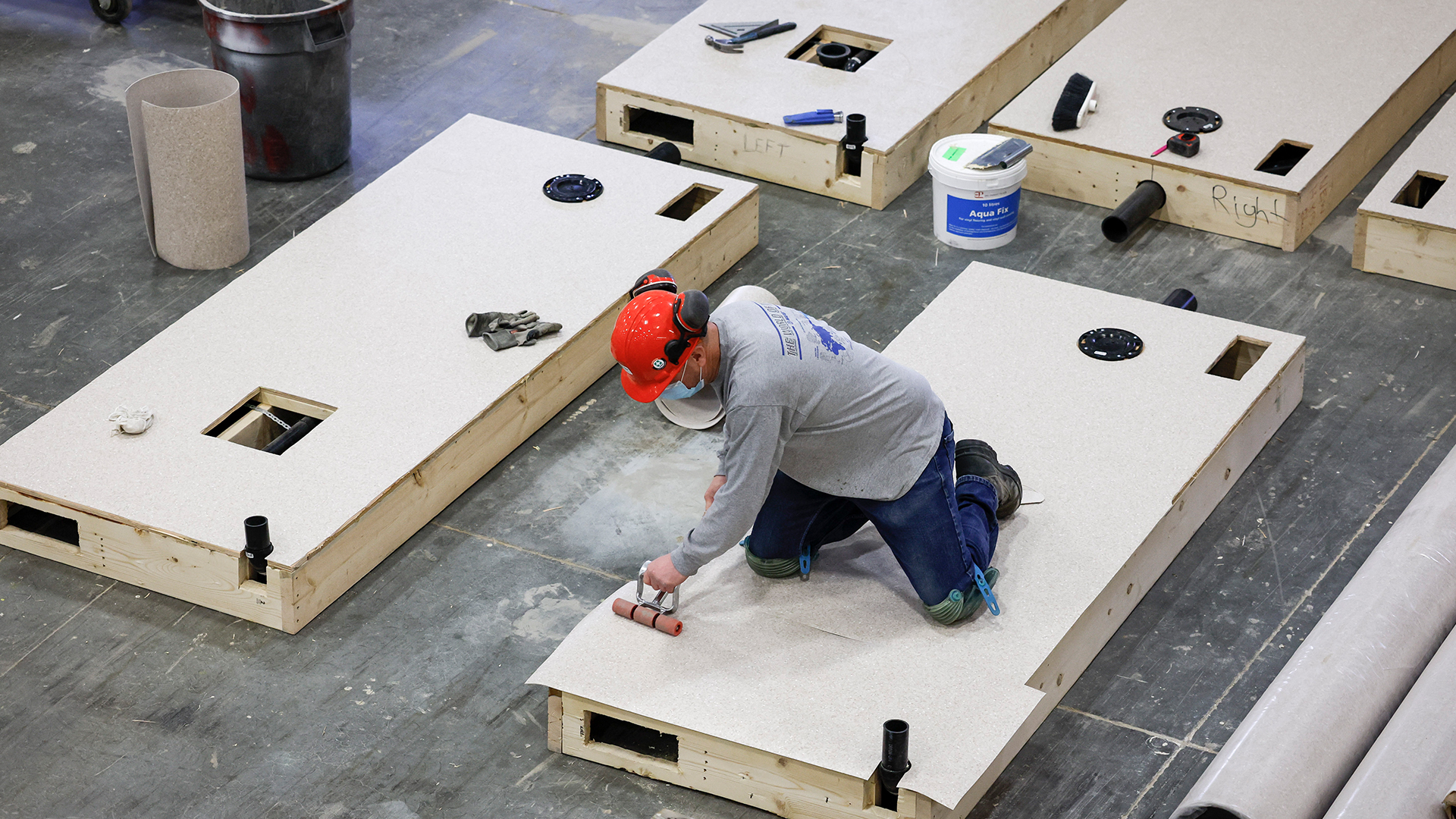
Canada is in a housing crisis, but we’re not giving ourselves a fighting chance to fix it. That needs to change.
Instead of making widespread use of innovations in housing construction efficiency, we’re primarily relying on slower and increasingly outdated, century-old methods.
The way forward is prefabricated housing, which offers a host of benefits over traditional onsite construction, such as lower costs and time savings, as the clock is running out to solve the crisis.
The federal government has already taken some action as seen with the recent funding announcement by Prime Minister Justin Trudeau, but there are multiple other steps that it can and should take now to bolster the use of prefabricated housing and to pull the country out of this downward affordability spiral.
For their part, provincial and municipal governments, which have the primary responsibility for housing, could ensure that transportation laws, zoning bylaws, building codes and approval processes are conducive to prefabricated housing development.
The Canada Mortgage and Housing Corporation (CMHC) says Canada needs about 5.8 million more homes by 2030. The real number may be higher.
The severe housing supply shortage has numerous detrimental effects that ripple through the economy and society. To make matters worse, housing affordability is at its worst level in 41 years while escalating prices diminish the quality of lifefor many Canadians.
Benefits of prefabricated construction
The three main types of prefabricated construction are mass timber, panelized, and modular. All of these involve offsite manufacturing of components which are then rapidly assembled onsite, offering a host of benefits compared to traditional construction methods.
Mass timber, where building components are made from multiple layers of wood fastened together, can halve the number of workers needed compared to concrete construction. This makes it especially valuable during the current labour shortage in the industry because construction timelines can be accelerated by up to 30 per cent.
Panelized construction, where individual panels are assembled into a complete structure, creates opportunities for lower labour and material costs as well as time savings of approximately 30 per cent.
With modular construction, manufacturing facilities use precise equipment to construct three-dimensional units, resulting in less waste during the production process, as well as greater quality control and environmentally friendly air-sealing. This kind of construction can reduce build times by 20 to 50 per cent.
Prefabricated construction provides increased certainty on project timelines and costs, which is highly valuable for the viability of projects.
Why has prefabricated construction not become more popular?
Market adoption for mass timber, panelized and modular housing is still in the early stages. Despite the benefits, they have not yet established themselves as the method of choice for homebuilders. Several reasons explain the hesitancy.
One is the lack of understanding and experience among builders about how to employ prefabricated technologies. Transportation of components from factory to site and other logistics are another barrier.
Contract uncertainty and the large investment needed to establish and run a manufacturing facility are the most significant barriers. Once the industry gets to scale, greater productivity and lower costs will encourage mass adoption.
Cost savings remain a debate
However, prefabricated construction benefits will not go far unless the price is right. The home building industry has not reached a consensus about whether offsite is cheaper than onsite building.
According to McKinsey & Company, modular construction presents an opportunity for 20-per-cent cost savings. The CMHC says it can be more affordable, but not always.
Hard construction costs such as dollars per square foot may be higher with prefabricated methods. However, the number of labour hours saved can be significant, along with other benefits which may outweigh hard construction costs.
A 2021 report from the Cambridge Centre for Housing & Planning Research in the U.K. concurs: “It is expected that, if such methods could be deployed at a greater scale, they may provide an opportunity to deliver new homes more quickly, with higher quality and at a potentially cheaper cost than traditional methods.”
Getting the industry to scale will require contract certainty to lower per-unit costs. Prefabricated construction firms may need assistance with the high capital cost and overhead of running their production facilities as they move toward scale.
What has the federal government done to date?
Ottawa’s actions to support prefabricated housing have been timid but encouraging.
A key factor in improving efficiency and quality is the scientific research and experimental development (SR&ED) tax credit, which is available to manufacturers.
In addition, prefabricated construction meets the objective of the $550.8-million affordable housing innovation fund and some of its recipients have included modular developments.
Applicants to the $300-million housing supply challenge have received funding to focus on prefabricated housing. Most importantly, the $4-billion rapid housing initiative employed modular development to rapidly add new housing supply by taking advantage of its time savings.
However, numerous policies could be put in place to encourage expansion to rapidly add supply and ease the housing crisis while bringing costs down.
The federal government has expressed recent interest in further supporting prefabricated construction. However, progress currently remains in the framework stage rather than the development of firm policies and details. The government must put the right measures forward to reap all possible benefits.
Policy recommendations
One effective way is to offer manufacturers greater assurance through contracts and funding arrangements across different funding channels.
For example, the federal government could help match interested developers who want to develop their land with prefabricated housing suppliers.
In addition, a funding stream could be utilized to support the initial phase of production with accredited manufacturers. This would give manufacturers the confidence and stability needed to invest in expanding their production cycles, while simultaneously reducing variable costs and enhancing productivity through accumulated experience.
This funding guarantee could be backed by an underlying asset that the government could temporarily acquire on its balance sheet before transferring it to an interested developer.
Potential funding levers may include expanding the Canada Infrastructure Bank’s focus or employing the strategic innovation fund for larger projects.
In addition, the upcoming pre-approved home design catalogue presents an opportunity to further strengthen the industry.
The second way the federal government can encourage industry is by ensuring the housing accelerator fund boosts prefabricated housing. The program’s current design discourages municipalities from helping developers and early adopters from accelerating the use of prefabricated housing. The fund should be expanded or renewed with a component (up to 10 per cent) set aside for municipalities.
At the provincial and municipal levels, there are numerous actions those governments could also take to incentivize prefabricated housing.
The Ontario Real Estate Association (OREA) has identified amending trucking laws, accelerating municipal approval timelines and amending zoning bylaws as key steps to support the scaling of prefabricated homes.
Half-load restrictions mandated by Ontario’s Highway Traffic Act of 1990 can hinder the transportation of modules from factories to building sites during the spring thaw. This creates transportation delays for manufacturers, leading them to operate below full production capacity from March to May.
Enforcing approval timelines for prefabricated housing construction could lead to steady orders and cash flow for manufacturers. This could enable manufacturers to expand their operations and scale up the industry, eventually making it more affordable for consumers.
By educating municipalities about the importance and speed of prefabricated housing construction, we can reduce confusion among municipal staff and speed up the approval process.
It is crucial to ensure that prefabricated homes are not conflated with other types of homes subject to NIMBYism and complex zoning requirements, such as mobile homes. When areas are not zoned for mobile homes and prefabricated homes are mistaken to be mobile, further approval process delays can occur.
Finally, there’s a need for better collaboration between all governments, industry and labour on how to change. A construction innovation strategy table should be created, to be led by federal departments.
Speed is of the essence. Prefabricated housing presents an opportunity to remedy the issues plaguing Canada by rapidly adding supply. It’s time we innovate to solve the housing crisis so more Canadians can find a place to call home.
This article is part of a series called How does Canada fix the housing crisis?









